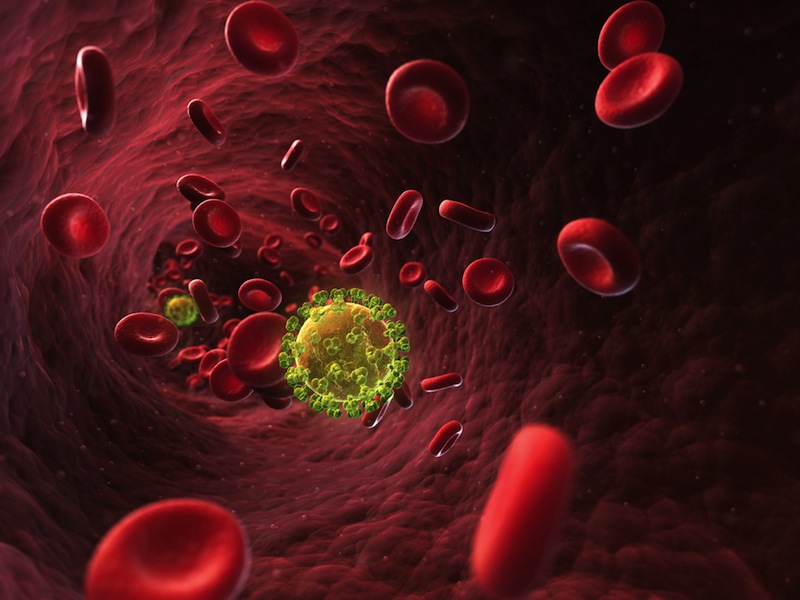When you buy through links on our site , we may realize an affiliate committee . Here ’s how it works .
A heterosexual someone infected with HIV will beam the computer virus to their partner once in every 900 time the couple has unprotected sex , according to a new study conducted in Africa .
However , the exact number of sexual act that are need to transmit the virus can vary enormously depending on the amount of the virus in the infected person ’s rip , said field of study researcher James Hughes , of the University of Washington in Seattle .

An image of the human immunodeficiency virus (HIV), taken with a scanning electron microscope. The multiple round bumps on the cell surface represent sites of assembly and budding of HIV particles. HIV is responsible for Acquired Immunodeficiency Syndrome (AIDS).
In fact , the amount of virus in the blood is the undivided most significant agent in determining whether HIV is passed between sexual partners , the study found . For every tenfold increment in the concentration , there is about a threefold increase in the danger of transmission system during a single sexual act .
mass with very high ancestry concentrations of the computer virus ( such as those who very latterly acquired the infection ) may take to have sexual practice only 10 time to transmit the computer virus , Hughes say . " The norm can be a slight deceptive , " Hughes said .
The new finding reward the musical theme that the good methods for keep down HIV transmittance are those that decrease the denseness of the computer virus in the blood , as can be done with antiretroviral drug , Hughes said . A study published last yr find the drugs couldreduce the transmission of HIV between partners by 96 pct .

The young report also confirmedcondomsare highly effective in preventing HIV infection , reducing the risk of infection of transmitting by 78 percent . Male circumcision reduced the danger of HIV transmittal by 47 percent .
HIV transmission
former study attempted to estimate the rate of HIV transmission , but were typically quite modest , and did not value the denseness of the virus in the rakehell throughout the entire study full stop .

The newfangled report included 3,297 couples from sub - Saharan Africa that were " HIV - discordant , " mean one partner had HIV while the other did not . TheHIV - infected partnersin the report were tested periodically over the two - year study for the amount of HIV in their descent . Infected partners were also interviewed every month and asked how many time they had sex , and whether they used protection .
The uninfected married person were tested sporadically to see whether they had get HIV . The researchers used genetic testing of the computer virus to affirm that any raw HIV infections had been acquired from the study pardner designate at the sketch ’s start .
Eighty - six HIV infection occurred during the study period .

Men were about double as likely to transmit HIV to women as women were to men . This increase risk of infection could be attribute to higher computer virus concentrations in the blood of men compare with cleaning woman , according to the field . In summation , women were more potential to havegenital herpes virus , which increases susceptibleness to HIV . [ AIDS by the Numbers ]
Condoms were cover to be used in 93 percent of sexual acts , but the researchers mistrust their manipulation was overreported . Therefore , safety in reality may be even more in force at prevent HIV transmission than the 78 percentage reducing that the investigator estimated , Hughes said .
The AIDS epidemic

The study swear on ego - reports , which might be wrong . However , error in reports of the numeral of sexual acts would be unlikely to affect most of the survey results , Hughes enounce .
The mean risk of HIV transmission per intimate number estimated in the cogitation is consistent with what has been found by previous research , but there are many situations in which that number may not apply , " said Dr. Myron Cohen , a professor of medicine , microbiology , immunology and public health at the University of North Carolina at Chapel Hill , who was not call for in the employment .
That ’s because the participant included in the discipline are twosome that have remained together and dissonant over a tenacious period of clip . This indicates the twosome might have some biological protection against transmission , Cohen say .

" The straight idea might be high-pitched if you were analyse different kinds of people , " Cohen said .
While most of the finding are likely generalizable to other country , the number of intimate acts needed to transmit the virus is likely specific to the African population meditate , Hughes said . Previous survey in the United States have found a down transmission rate .
In improver , the findings only apply to heterosexual couples , and not man who have sex with men , a group that is likely to have a much eminent transmission pace , Hughes say .

Pass it on : The secure way to tighten the risk of HIV transmission is to take down the amount of the virus in the lineage .











